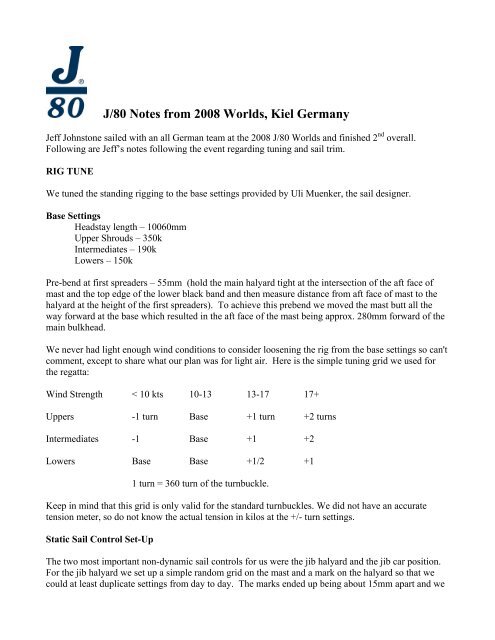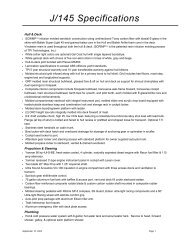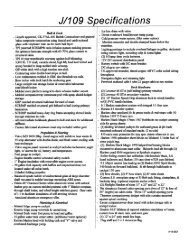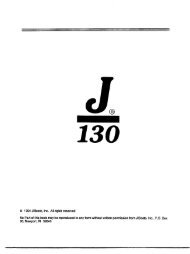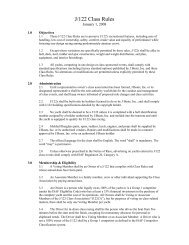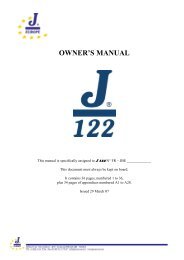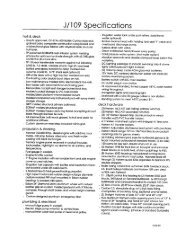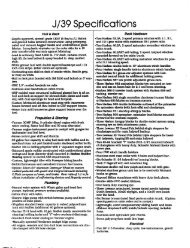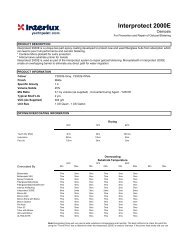Tuning & Trimming Tips from 08 Kiel Worlds - J/Owners
Tuning & Trimming Tips from 08 Kiel Worlds - J/Owners
Tuning & Trimming Tips from 08 Kiel Worlds - J/Owners
Create successful ePaper yourself
Turn your PDF publications into a flip-book with our unique Google optimized e-Paper software.
J/80 Notes <strong>from</strong> 20<strong>08</strong> <strong>Worlds</strong>, <strong>Kiel</strong> GermanyJeff Johnstone sailed with an all German team at the 20<strong>08</strong> J/80 <strong>Worlds</strong> and finished 2 nd overall.Following are Jeff’s notes following the event regarding tuning and sail trim.RIG TUNEWe tuned the standing rigging to the base settings provided by Uli Muenker, the sail designer.Base SettingsHeadstay length – 10060mmUpper Shrouds – 350kIntermediates – 190kLowers – 150kPre-bend at first spreaders – 55mm (hold the main halyard tight at the intersection of the aft face ofmast and the top edge of the lower black band and then measure distance <strong>from</strong> aft face of mast to thehalyard at the height of the first spreaders). To achieve this prebend we moved the mast butt all theway forward at the base which resulted in the aft face of the mast being approx. 280mm forward of themain bulkhead.We never had light enough wind conditions to consider loosening the rig <strong>from</strong> the base settings so can'tcomment, except to share what our plan was for light air. Here is the simple tuning grid we used forthe regatta:Wind Strength < 10 kts 10-13 13-17 17+Uppers -1 turn Base +1 turn +2 turnsIntermediates -1 Base +1 +2Lowers Base Base +1/2 +11 turn = 360 turn of the turnbuckle.Keep in mind that this grid is only valid for the standard turnbuckles. We did not have an accuratetension meter, so do not know the actual tension in kilos at the +/- turn settings.Static Sail Control Set-UpThe two most important non-dynamic sail controls for us were the jib halyard and the jib car position.For the jib halyard we set up a simple random grid on the mast and a mark on the halyard so that wecould at least duplicate settings <strong>from</strong> day to day. The marks ended up being about 15mm apart and we
generally were in between the #5 and #7 position representing a total jib halyard range of about 40mmbetween 10 and 25 knots. We thought in general that most boats didn't carry enough jib halyardtension in the windier conditions. With the Kevlar jib, it's important to have a low stretch halyard thatwill hold its position. It's also important to at least have a way of running the jib halyard tail to awinch. We rigged a block to the mast eye near the deck and then another at the stanchion base in orderto be able to lead the halyard to the cockpit. (CAUTION – the mast ring at deck was not designed forhigh halyard loads so you must rig a short rope strop around the mast to the other eye – also the samefor the stanchion base – run a short strop around the entire base, don't just shackle to the little leg).We drilled intermediary holes in the jib track so that we didn't have to reverse the jib car in order tofine-tune the jib lead position. The stock Ronstan jib track has holes every 50mm, so we drilled twointermediary holes spaced at roughly 17mm apart. For the regatta we found that we used threedifferent positions. Our all purpose medium air setting was what we called the #3 hole, which was veryclose to the front of the cabin window. We liked this lead when we were sailing with full crew on therail and ½-¾ backstay tension. In this position, we found we could trim the jib hard enough to get afirm leech and point high in the flat spots, but also ease the sheet 30-40mm and twist off the leech forgoing fast through waves. Once we reached full backstay tension and were starting to carry somebubble in the main to depower, we slid the lead aft to the #4 hole, which was the first stock track holein front of the shrouds. When it got windier (over 18 knots) we slid back one more hole to #5. On Day1 and 4 of racing we shifted between the #4 and #5 lead. On Day 2 and 3 we were mostly in #3 all day.If lighter (under 10 knots) we would have likely gone to #2.For the other non-dynamic controls (cunningham and outhaul) we followed the normal procedure ofpulling harder when it got windier. We did notice that many boats did not have enough cunninghamtension in the windy races. The mainsail draft should be at about 50%. If you pull the backstay downall the way and don't pull the cunningham hard enough to remove wrinkles, then the draft will be 60%or more aft, which is not a good airfoil. For the outhaul, it is also very easy to let it out too muchdownwind. Yes you want to release to uncrease the foot but if you let out too much you reduceprojected sail area.Dynamic Sail ControlsThe most critical sail controls on any sailboat are the sheets, and this was really evident for us on theJ/80 this week. In the rapidly changing wind conditions we decided <strong>from</strong> the outset to trim the jib on
the windward side and to never cleat the sheet. It made for slightly slower tacks on pulling in the sheet,but this was made up for by having all of the crew on the new windward side right after the tack. Italso allowed us to quickly ease and re-trim sheet in order to balance the boat, if I oversteered in thetack or we were hit with a puff and I wasn't quick enough releasing the mainsheet. In fact, at times itwas better to ease the jib 30-40mm in a puff than to release the main, so that we could keep the boatflat and not reduce our pointing ability.The next most important control to the sheets is the backstay. On all but the windiest races, we wereadjusting the backstay all the time upwind. It’s the only control that can quickly change the shape ofboth the main and the jib, and have and immediate impact on your steering balance. On Day three,when sailing near the top of the upwind leg in the flatter water, we found ourselves sometimes justplaying the backstay in the puffs and nothing else.We were asked about our use of the boomvang and the traveler, and I must admit that we did very littleadjusting of these when the wind was more than 14 knots. In the J/24 we like to vang sheet in windyconditions, pulling in the vang quite hard, and then playing the mainsheet. However, the J/80 has along boom and overvanging can actually create too much windward helm – due to closing off the lowerbattens. We would trim the mainsheet into maximum position for the upwind leg and simply take upthe slack on the vang. We would then play the sheet in and out in order to keep a constant light toughon the tiller, with the additional goal of matching up the leech profiles of both the main and jib. If oneleech were tighter than the other, then the boat would not feel balanced. In general, we were carrying afair amount of twist in both leeches upwind, and this gave me a wide steering groove which wasessential in the chop.Other Boat Prep tip:One of the key boat preparation items we spent time on was how to reduce the friction and likelihoodof ripping the gennaker when launching and lowering the sail. Many of the boats at the regatta had afew of these anti-chafe measurers, but I don’t believe anyone spent as much time as we did on it. Hereare some of the “little” things we did:1) Add mylar vang cover over the boomvang purchase.2) Install a small pvc roller across the port corner of the companionway opening.3) Add a cover, tube or Teflon tape to the port side upper shroud.4) Add a cover, tube or Teflon tape to the port side lifeline.5) Add a rubber tube/hose to the mainsheet strop to reduce chafe on the sheet.After getting the gennaker under the boat on our first hoist of the practice race, thereafter we bandedthe first 10 feet of the tack (with elastic rubber bands) for every first set of every race. We really likedthis as we were able to prefeed the tack all the way to the bow, even during the tight offset legs withoutworrying about the foot catching the water.


